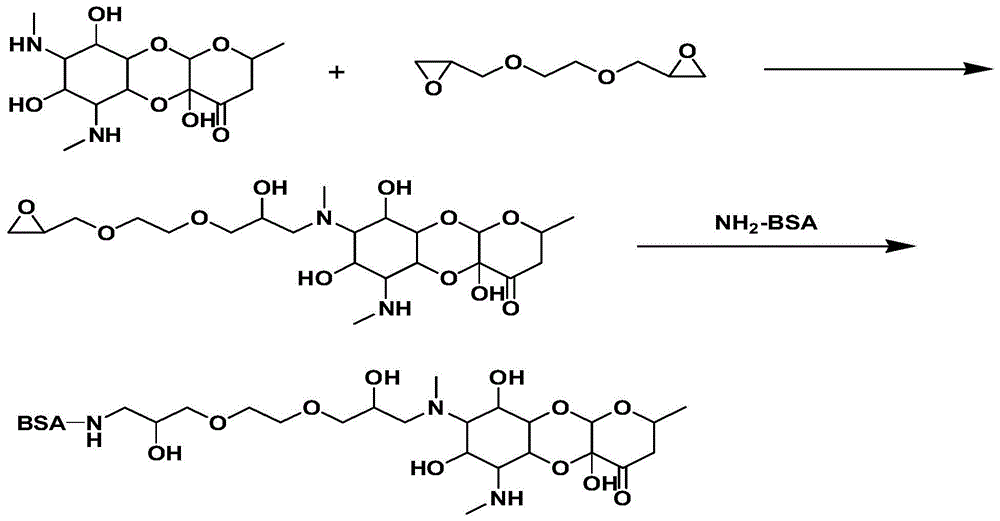Hapten spe-ede and its corresponding artificial antigen and its application
A compound, diglycidyl ether technology, applied in animal/human protein, anti-bacterial immunoglobulin, serum albumin, etc., can solve the problems of unsatisfactory rapid detection, expensive instruments, high detection cost, etc., and achieve low cost, High potency, simple instrument requirements
- Summary
- Abstract
- Description
- Claims
- Application Information
AI Technical Summary
Problems solved by technology
Method used
Image
Examples
Embodiment 1
[0031] Embodiment 1, the preparation of immunogen and coating former
[0032] The schematic diagram of the synthetic route of SPE-EDE-BSA is shown in figure 1 .
[0033] 1. Preparation of hapten
[0034] Dissolve 37.5mg spectinomycin hydrochloride in 5mL3g / 100ml NaHCO 3 Aqueous solution, add 0.5mL EDE-DMF solution dropwise while stirring under ice bath conditions (20mg EDE is dissolved in 0.5mL DMF to obtain 0.5mL EDE-DMF solution), and then stir at 4°C for 15min to obtain a hapten solution (the hapten is SPE-EDE).
[0035] The hapten is represented by formula (I).
[0036] Formula (Ⅰ).
[0037] 2. Preparation of immunogen
[0038] 1. Dissolve 50mg BSA in 5mL0.1mol / L Na 2 CO 3 aqueous solution.
[0039] 2. Add the hapten solution obtained in step 1 dropwise into the BSA solution obtained in step 1 while stirring, and then stir at room temperature for 16 hours.
[0040] 3. Take the solution obtained in step 2, put it into a dialysis bag, and dialyze it in PBS buffer...
Embodiment 2
[0043] Embodiment 2, the preparation of polyclonal antibody
[0044] Dilute the immunogen solution prepared in Example 1 with sterilized physiological saline to a solution of 2 mg / mL (based on protein content), add an equal volume of Freund's complete adjuvant for emulsification, and obtain the first immune preparation. Dilute the immunogen solution prepared in Example 1 with sterilized physiological saline to a solution of 2 mg / mL (based on protein content), add an equal volume of Freund's incomplete adjuvant for emulsification, and obtain a booster immune preparation.
[0045] Take 4-month-old female New Zealand white rabbits: the first immunization is carried out by multi-point intradermal injection on the back of the neck. , 4 weeks later, 6 weeks later, 8 weeks later and 10 weeks later each booster immunization once, using multi-point subcutaneous injection on the back of the neck. ); 10 days after the last booster immunization, blood was collected from the heart, serum ...
Embodiment 3
[0046] Example 3, Determination of Optimal Coating Concentration and Optimal Antibody Working Concentration
[0047]Using the square method. The original coating solution prepared in Example 1 was serially diluted 1:1000 to 1:50000 times (volume ratio) with carbonate buffer solution (pH 9.5, 0.05 mol / L). The serum (antibody) prepared in Example 2 was serially diluted from 1:1000 to 1:100000 times (volume ratio) with PBS buffer (pH7.4, 0.01mol / L). The best antigen coating concentration and the best antibody working concentration were determined by indirect ELISA method. by OD 490nm When the value is close to 1.5, the corresponding antigen coating concentration and antibody concentration are the optimal antigen coating concentration and the optimal antibody working concentration.
[0048] The optimal coating concentration of the coating source (SPE-EDE-OVA) is 0.3 μg / mL (based on protein amount), and the optimal working concentration of the antibody is 1:1500.
PUM
 Login to View More
Login to View More Abstract
Description
Claims
Application Information
 Login to View More
Login to View More - R&D
- Intellectual Property
- Life Sciences
- Materials
- Tech Scout
- Unparalleled Data Quality
- Higher Quality Content
- 60% Fewer Hallucinations
Browse by: Latest US Patents, China's latest patents, Technical Efficacy Thesaurus, Application Domain, Technology Topic, Popular Technical Reports.
© 2025 PatSnap. All rights reserved.Legal|Privacy policy|Modern Slavery Act Transparency Statement|Sitemap|About US| Contact US: help@patsnap.com



